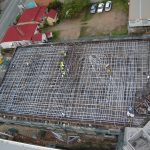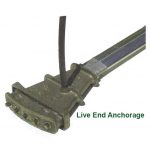What Is Post-Tensioning?
Concrete is one of the most widely used construction materials in the world. It is made up of natural stone called aggregate, sand, water and portland cement, which is made from firing a mixture of clay and limestone at high temperature then ground into a fine powder.
To strengthen the concrete and help control crack width and allow adequate flexural strength, reinforcing is placed within the concrete section. However concrete is strongest under compression; By providing high tensile strands (cables) in lue of reinforcing, the concrete is placed under compression, making it stronger and allowing in to span further, with thinner sections than that of reinforced concrete sections.
The application of applying a force to the high tensile strands is known as prestressing (the primary/family name). Stressing of the high tensile strands within the section either happens before the placing of the concrete, known as pre-tensioning, or after the concrete has been placed which is known as post-tensioning.
Pre-tensioning generally occurs in a precast yards, as the strands are tensioned against abutments. The concrete in placed around the prestressing strands in appropriate formwork and when in has gained sufficient concrete strength the prestressing force can be released from the abutments, pre-compressing the concrete due to a bond between the strand and the concrete that occurs, this forces the concrete into compression.
Post-Tensioning is a lot more flexible, it does not require a yard and can be implemented on the construction site. In post-tensioning construction a number of strands are placed within a duct within the concrete section. At each end of the duct an anchorage in formed being either a dead end or live end anchor. The concrete is then poured and left to reach sufficient strength then tension is applied to the strands by using a hydraulic jack at the live end. Upon completion of post-tensioning the tendons are pressure grouted resulting in a fully bonded tendon within the duct and concrete section.
Post-tensioning can be completed in large pre-casting units for the insitu construction of large structures such as bridges, bridge girders and transfer beams.
Given the versatility and cost advantages of prestressed and reinforced concrete, they both find their way into many forms of construction including buildings, bridges, power plants, towers, water and sewerage plants, dams, nuclear reactors, offshore oil drilling platforms, permanent water tanks and other water retaining structures.


